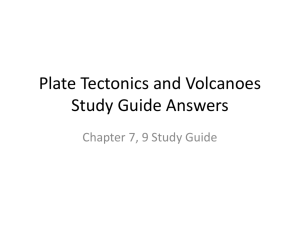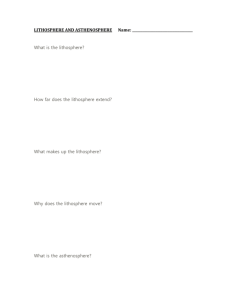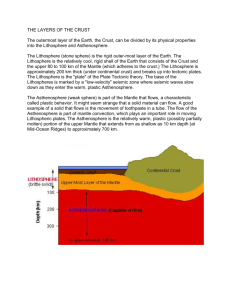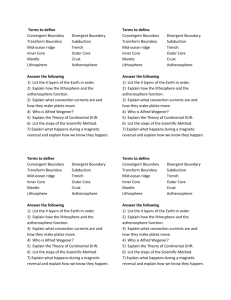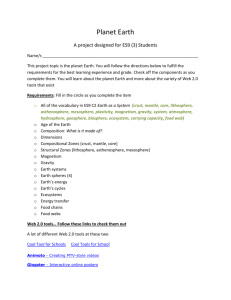Boundary Layers: The lithosphere + asthenosphere Petrology
advertisement
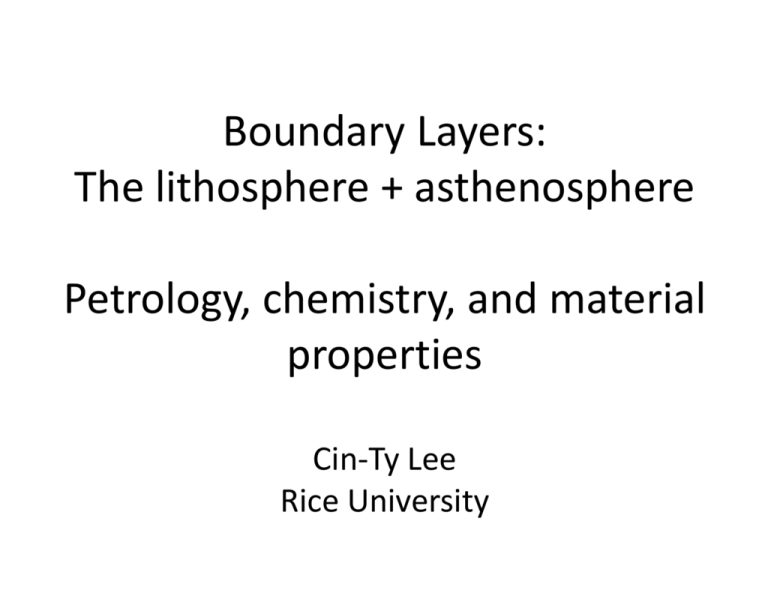
Boundary Layers: The lithosphere + asthenosphere Petrology, chemistry, and material properties Cin-Ty Lee Rice University Oceans and Continents Plate Tectonics Parsons and Sclater 1977 Stein and Stein 1992 T (oC) 1600 1400 1200 1000 800 600 400 200 0 0 2 Ma 25 Z (depth) Ocean basins 10 50 75 L 75 100 125 150 Oceans basins are manifestations of upper thermal boundary layer L ~ κt q~k ∆T k∆T ~ L κt buoyancy ~ ρ ∆T κt L ρo ∆T ~ o 2 2 Oceanic thermal boundary layers become negatively buoyant and subduct when negative buoyancy forces > resisting forces Oldest oceanic crust is ~200 My ρref=STP (kg/m3) T (oC) 25 10 Oceanic Mantle 10 75 Z (depth) 50 75 TP = 1300 oC TP = 1375 oC 75 100 TP = 1450 oC Fertile Mantle 125 A 150 B 3500 2 Ma 2 Ma 3480 3460 3440 3420 3400 3380 3360 3340 3320 1600 1400 1200 1000 800 600 400 200 0 0 Ocean basins = mobile thermal boundary layer =Plate tectonics Tackley 2000 Continents underlain by thicker thermal boundary layers Temperature (oC) 0 200 400 600 800 1000 1200 1400 1600 0 1 P (GPa) 2 Thickness of oceanic lithosphere 80 3 70 4 60 5 50 6 7 Mantle xenoliths Craton thickness 40 8 Lee et al. 2005 Continents are cold (H. N. Pollack, S. J. Hurter, and J. R. Johnson, Reviews of Geophysics, Vol. 31, 1993.) Continents are old = stagnant (Nd model ages and U-Pb crystallization ages) Fraction of crust in 200 Ma intervals 0.15 0.10 Age of oldest seafloor 0.05 0.00 0 1 2 3 4 Time (Ga) McCulloch & Bennett, 1994 Ocean Plume Midocean Ridge Mantle Core Continental Crust Base of lithosphere Why is the upper thermal boundary layer important? • Nature of TBL controls heat loss from planet • Melting and differentiation occur (unmixing) • Homogenization and mixing occurs Melting and differentiation occur at thermal boundary layers Mid-ocean Ridge Hoffmann Island and continental arcs Cooling of Earth unmixes the Earth CRUST is formed Cont. crust mafic 3.0 g/cm3 felsic 2.7 g/cm3 Melting also leaves behind a depleted mantle residuum (which could reside in the thermal boundary layer) Olivine A 94 Dunite Melt depletion 92 Mg# 90 Lherzolite B 88 Olivine websterite 100 95 90 85 80 75 70 65 60 55 50 Olivine mode Orthopyroxene 0.1 0.2 0.3 0.4 0.5 0.6 0.7 0.8 0.9 94 Clinopyroxene Wt. Fraction in peridotite 92 Mg# Spinel Facies Garnet Facies Garnet Per. Spinel Per. 90 C 100 95 90 85 80 75 70 65 Olivine Mode (wt. %) Lee 2003 60 55 50 88 3.420 4.90 4.88 4.86 4.84 4.82 4.80 4.78 4.76 4.74 4.72 4.70 4.68 STP Bulk Density g/cm3 STP Vs (km/s) STP SHEAR VELOCITIES VS = (0.0143±0.0009)Mg# + (3.53±0.08) R2 = 0.71 Garnet facies (garnet-peridotite) Garnet facies (spinel-peridotite ( ) ρ = -0.0144Mg# + 4.66 r2 = 0.67 3.400 3.380 3.360 3.340 3.320 A Spinel facies 3.300 84 86 88 90 Mg#BULK 92 94 96 88 89 90 91 92 93 94 Mg#BULK Lee 2003 Oceanic and continental lithosphere can serve as “sponges” for fluids/melts Metasomatism Layer of heat-production 1600 1400 Radioactive layer Temp C 1200 1000 800 600 400 200 0 0 50 100 Depth km 150 200 Implications for estimates of Primitive Upper Mantle from Peridotites Some peridotites could be refertilized Peter Luffi Na 2 O PM 5 10 batch aggregate liquid 15 20 near-fractional MgO 25 Dish Hill East Romanche (Seyler & Bonatti, 1997) D, L, H – MORB end-members from Elthon (1992) mixing also occurs in the upper thermal boundary layer Hunt & Kellogg Pure shear Simple shear l ~ lo e x ~ Gt xo − Gt l First order characteristics of the upper thermal boundary layer? • Compositional transition • Rheologic transition • Change in other physical properties (K, G) Constitutive relationships Brittle deformation (fracture strength) Plastic deformation τ fric = τ c + µ f σ N E + PV ε& = A m exp − d RT σn Dislocation Creep n~3 m=0 Kohlstedt et al. 1995 Diffusion Creep n~1 m = 1-2 As Frost and Ashby http://engineering.dartmouth.edu/defmech/ Frost and Ashby http://engineering.dartmouth.edu/defmech/ Ductile deformation is temperature-sensitive viscosity decreases with temperature E + PV RT η = ηo exp Viscous boundary layer can be defined to first order by a temperature isotherm ~1100-1200 o C Ranalli and Murphy 1987 Kohlstedt et al 1995 Lithosphere & asthenosphere Rheologic definitions • Lithosphere = “strong” layer from Greek lithos = “rocky” • Asthenosphere = “weak” layer from Greek astheno = weak How weak is the asthenosphere and why do we care? A low viscosity zone (LVisZ) can give rise to long wavelength convection e.g., plate tectonics Hoink and Lenardic 2008 See also Richards et al. 2001 ε& = A How does one generate a low viscosity zone? Viscosity Pas T(C) Viscosity Pas 140 140 120 140 120 100 120 100 80 100 80 60 80 60 40 60 40 20 40 20 0 20 0 0 E = 500 kJ/mol V = 15 cm3 /mol E = 400 kJ/mol V = 60 cm3 /mol Flow law (wet olivine; Hirth and Kohlstedt 1995) Unrealistically high V 1E+25 1E+24 1E+23 1E+22 1E+21 1E+20 1E+19 1E+18 1E+17 1E+16 1E+25 1E+24 1E+23 1E+22 1E+21 1E+20 1E+19 1E+18 1E+17 1E+16 1600 1400 1200 1000 800 600 400 200 0 depth E + PV exp − m d RT σn Lithosphere & asthenosphere Other “definitions” are really observables Seismic Low Velocity Zone (LVZ) = asthenosphere? Seismic Lid = Lithosphere? Thermal lithosphere = lithosphere? Tectosphere, compositional boundary layer = Lithosphere? Fertile “convecting” mantle = asthenosphere? Elastic lithosphere thickness = lithosphere? Which one of these “definitions” actually = lithosphere and asthenosphere? Be careful of confusing these terms with the rheologic definition of lithosphere Reminder – RHEOLOGICAL LITHOSPHERE is to first order controlled by temperature Viscous boundary layer can be defined to first order by a temperature isotherm ~1100-1200 o C Thermal Boundary Layer (thermal lithosphere) Ranalli and Murphy 1987 Kohlstedt et al 1995 Seismic Lid and Low Velocity Zone (LVelZ) seismic lithosphere LVZ LVZ > 5% drop in Vs LVZ – nonexistant in shields? Gaherty et al. 1999 LVelZ may coincide with anisotropy Compositional boundary layers – chemical lithosphere Continents Lee 2005 but many others: Jordan, Hirth & Kohlstedt, Pollack Compositional boundary layers – chemical lithosphere Oceans Lee et al. 2005 Motivated by Hirth and Kohlstedt 1995 Elastic Thickness Based on flexure and loading studies with elastic plate approximation Effective elastic thickness – always less than thermal thickness and rheological lithosphere For oceans, roughly follows isotherms OCEANS Compilation from Burov and Diament 1995 But for continents, it’s very difficult to do flexural studies (too strong so little topographic signal) Effective elastic thickness – much less than thermal thickness and rheological lithosphere and often with large uncertainty What is the nature of the lithosphere-asthenosphere boundary (LAB)? Identify the depth of the LAB Identify the thickness of the asthenosphere and its viscosity Hypotheses 1 – asthenosphere = partial melting zone 2 – asthenosphere = wet channel 3 - asthenospehre = thermal weakening (no melting) Seismic Lid and Low Velocity Zone (LVelZ) LVZ LVZ > 5% drop in Vs LVZ – nonexistant in shields? Gaherty et al. 1999 Attenuation Q-1 Anelastic behavior viscous effects ∆E Q ≡ 2πE −1 Q −1 α E = A(ω )To exp − RT Q −1 ∝ (ωτ ) −α ∝ L−α Q −1 (ω , T ) E ∂ ln VS ∂ ln VSU = − F (α ) 2 ∂T ∂T π RT Faul and Jackson 2005 Q tomography Dalton, Ekstrom, Dziewonski (in press) What is the nature of the lithosphere-asthenosphere boundary (LAB)? Identify the depth of the LAB Identify the thickness of the asthenosphere and its viscosity Hypotheses 1 – asthenosphere = partial melting zone 2 – asthenosphere = wet channel 3 - asthenospehre = thermal weakening Hypothesis 1 Asthenosphere = partial melting zone LVZ = partial melting zone PEPI 1970 How much melt? Not much! < 0.2 % ? κ (φ ) v=− ∆ρg µ Bulau et al. 1979 Waff and Bulau 1979 Abyssal Peridotites Johnson et al. 1990 Hypothesis 2 LVelZ due only to thermal effects (solid state) anelastic and anharmonic effects Stixrude and Lithgow-Bertelloni 2005 Hypothesis 3 water or volatiles = LVZ Hirth and Kohlstedt 1996 1.4 ORTHOPYROXENE Cr2O3 (wt. %) 1.2 1.0 0.8 0.6 0.4 0.2 0.0 0 2 4 Al2O3 (wt. %) 6 8 The effect of water on mantle viscosity ηeff = τ ε ε = Aτ f r H 2O Q + PV exp(− ) RT Water fugacity 1573 K wet dry 10-4 Strain rate (S-1 ) n 10-3 10-5 Olivine 10-6 10-7 3×101 102 4×102 Stress (Mpa) Mei and Kohlstedt, 2000; Chopra and Paterson, 1984; Karato et al., 1986; Hirth and Kohlstedt, 1996 Li, Lee, Peslier, Lenardic, Mackwell (in press) 120o W 109o W 114o W 41o N 0 ol: 10 20 30 40 ppm 0.3 Mpa 0 10 20 30 40 ppm ol: 100 0 10 20 30 40 ppm ol: TH GC DH ol: N LVT 0 ol: 0 37o 150 10 20 30 40 ppm 10 20 30 40 ppm SC D 32o N 500 km 0 0 300 0 1019 1021 ηeff (Pa⋅⋅s) 600 50 100 ol: SMORB 200 1017 SOIB 150 ppm Hypothesis Testing (CIDER) Is the asthenosphere a partially molten zone? Need falsifiable predictions Must be interesting - implications PREDICTIONS T ZLAB ZLAB Z Heat flow Zbase ZLAB - Zbase Heat flow Step 1. Find places with different heat flows young ocean, old ocean, young continent, old continent Step 2. Use magma petrology and seismology to get ZLAB and Zbase Thermometers Mg2SiO4 (olivine) + Fe2SiO4 (melt) = Mg2SiO4 (melt) + Fe2SiO4 (olivine) Mg2SiO4 (olivine) = Mg2SiO4 (melt) ∆S f dP = dT 2ϕ ∆V f (Fe / Mg )ol = (Fe / Mg )melt small P 1900 1 atm = 0.1 MPa 1800 Temperature (oC) K Fe / Mg D T 1700 1600 T3 1500 T2 1400 LIQUID “forbidden zone” T1 S3 L3 X3 S2 X2 S1 L2 X1 L1 1300 OLIVINE 1200 1100 Mg2SiO4 X0 Wt. % Fayalite Fe2SiO4 Barometers (Lee et al.) Mg2SiO4(olivine) + SiO2(melt) = Mg2Si2O6(pyroxene) K (T , P) ~ K~ px a Mg 2 Si 2 O 6 ol melt a Mg 2 SiO 4 a SiO 2 large ∆S f dP = dT 2ϕ ∆V f 1 a melt SiO 2 1 atm = 0.1 MPa 1700 T1 Liquid + Forsterite T B LIQUID L + Si-poly 1600 T (oC) P Pe TPe TE E L + En 1500 Enstatite + Si-polymorph Forsterite + Enstatite Xo 1400 Forsterite Mg2SiO4 X1 Enstatite MgSiO3 SiO2 Wt. % of course, one needs to make sure that the magmas of interest are not plume-related! Seismology Levander and Miller western Basin and Range <1 Ma (Big Pine, CA) <1 Ma (Coso, CA) <1 Ma (Amboy, CA) <1 Ma (Pisgah, CA) Rio Grande Rift <1 Ma (Zuni Bandera, NM) Colorado Plateau <1 Ma (San Francisco, AZ) Snake River Plain Basin and Range Colorado Plateau T (oC) Levander and Miller 1300 1400 1500 1600 1700 0 TP 20 40 LABBR 60 80 LABCP 100 120 Depth (km) P (GPa) 1200 0.0 0.5 1.0 1.5 2.0 2.5 3.0 3.5 4.0 4.5 5.0 5.5 6.0 6.5 7.0 140 160 180 Western North America 200 220 Lee et al. PREDICTIONS ZLAB T ZLAB Heat flow Z Zbase ZLAB - Zbase Heat flow ZLAB seismology ZLAB petrology Step 3 Calculate reference velocity profiles anharmonic (solid state) anharmonic and anelastic (Q) (solid state) anharmonic and anelastic (partial melt) Calculate viscosity profiles use dislocation and diffusion creep laws to calculate anhydrous viscosity profile assess effect of grain size assess effect of water assess effect of melt And finally, we head home to geodynamics ZLAB ∆Z Low Viscosity Channel Zbase Z Basal shear will be different beneath continents and oceans τ ∝ 2ηeff ε& ∝ 2ηeff V ∆Z Conrad and Lithgow-Bertelloni 2006 Why is Earth’s upper boundary layer close to its melting point?
